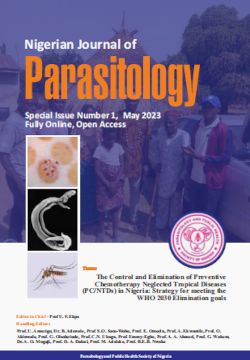Effect of Plasmodium falciparum Malaria Infection on the Amplitude of Accommodation of Young Adults in Elele, Rivers State, Nigeria
DOI:
https://doi.org/10.4314/njpar.v45i1.13Keywords:
Young adults, Plasmodium falciparum, Amplitude of Accommodation, MalariaAbstract
Plasmodium falciparum is the parasite responsible for most malarial infections in Nigeria. Malaria is the most widespread parasitic infectious disease in the world. This study aimed to determine the effect of Plasmodium falciparum malaria infection on the amplitude of accommodation (AA) in young adults. The study was a prospective laboratory and clinical study carried out at the Madonna University Teaching Hospital Elele, Rivers State, Nigeria. Young adults between the ages of 18 and 35 years were included in this study. Informed consent was obtained from the subjects to participate in the study. To confirm the presence of Plasmodium falciparum malaria infection, preliminary tests including case history, external and internal eye examination, retinoscopy, and subjective refraction were performed to determine subjects who satisfied the inclusion and exclusion criteria. The amplitude of accommodation using the push-up method was measured just before treatment and two weeks after recovery from malaria infection. Results show that the mean AAduring malaria infection was 7.25±1.73D and 9.03±1.72D after recovery; showing a mean difference of -1.78D (24.55%). This reduction in AA during
malaria infection was found to be statistically significant (t(119) = -33.3, p(0.00)˂0.05) when tested using the paired sample t-test at a significance level of 0.05.
References
Park, K. (2015). Preventive and Social Medicine, Jabalpur, India: Banarsidas Bhanot Publishers.
Kumar, V., Abbas, A.K., and Fausto, N. (2017). Pathologic Basis of Disease, New Delhi, India: Elsevier.
Oldenburg, C. E., Guerin, P. J., Berthe, F., Grais, R. F., and Isanaka, S. (2018). Malaria and Nutritional Status amongChildren with Severe Acute Malnutrition in Niger: A Prospective Cohort Study. Clinical Infectious Diseases, 67(7): 1027-1034. doi: 10.1093/cid/ciy207 (accessed 27 July 2023).
World Health Organization (2022).Malaria. https://www.who.int/newsroom/fact-sheets/detail/malaria (accessed 28 July 2023).
Bamiselu, O. F., Ajayi, I., Fawole, O., Dairo, D., Ajumobi, O., and Stephen, Y.(2016). Adherence to malaria diagnosis and treatment guidelines among healthcareworkers in Ogun State, Nigeria. BMC Public Health, 16: 829. doi: 10.1186/s12889-016-3495-x (accessed 28 July 2023).
Visa, T. I., Ajumobi, O., Bamgboye, E., Ajayi, I., and Nguku, P. (2020). Evaluation of malaria surveillance system in Kano State, Nigeria. 2013-2016, Infectious Diseases of Poverty, 9: 15. doi:10.1186/s40249-020-0629-2 (accessed 26 July 2023).
Mabey, D., Geoffrey, G. G., Eldryd, P., Weber, M. W., and Whitty, C. J. M.(2014). Principle of Medicine in Africa, Cambridge, England: Cambridge University Press.
Uzodike, E. B., and Ndukwe, E. K. (2010). Effect of Malaria on the Near Point of Convergence and Amplitude of Accommodation. Journal of Medicine and Medical Sciences, 1(11): 539-542.
Muhammad, H. U., Giwa, F. G., Olayinka, A. T., Balogun, S. M., and Nguku, P. (2016). Malaria prevention practices and delivery outcome: a cross sectional study of pregnant women attending a tertiary hospital in northeastern Nigeria. Malaria Journal, 15: 326. doi: 10.1186/s12936-016-1363-x
(accessed 27 July 2023).
Jain, A. (2017). Illustrated Textbook of Optics and Refractive Anomalies, St. Louis, USA: CBS Publishers and Distributors.
Elliot, D. B. (2020). Clinical Procedures in Primary Eye Care, Washington, USA:Elsevier.
Evans, B. J. W.(2021). Pickwell’s Binocular Vision Anomalies, Boston, USA: Elsevier.
Nwala, O. R., Ahuama, O. C., Ohiri, M. O., Azuamah, Y. C., and Onu, N. U. (2015). Distribution of Presbyopia among civil servants in Aba South LGA. Abia state. The Optometric Educator, 5(1): 8-13.
Schwartz, S. (2019). Geometrical and Visual Optics, America: McGraw-HillEducation.
Wolffsohn, J. S., Davies, L. N., and Sheppard, A. L. (2023). New insights in presbyopia: impact of correction strategies. BMJ Open Ophthalmology, 8(1): e001122. doi: 10.1136/bmjophth-2022-001122(accessed 27 July 2023).
Small, D. S., Taylor, T. E., Postels, D. G., Beare, N. A. V., Cheng, J., and Seydel, K. B. (2017). Evidence from a naturalexperiment that malaria parasitemia is pathogenic in retinopathy-negative cerebral malaria. eLife6 :e23699. doi:10.7554/eLife.23699 (accessed 26 July 2023).
Azuamah, Y. C., Esenwah, E. C.,Nwabueze, U. I., and Iwuala, C. C. (2013): Effect of malaria on the near point of convergence of the eye. International Journal of Environmental Health and Human Development, 14(1): 9-13.
Burns, D., Allen, P., Edgar, D., and Evans, B. (2020). Sources of error in clinical measurement of the amplitude of accommodation. Journal of Optometry, 13(1): 3-14.
Akujobi, A. U., Vincent, C. L., Ekenze, C. J., Obioma-Elemba, J. E., and Vincent, C. C. (2018). Assessment of amplitude of accommodation in Owerri Municipal Council, Southeast Nigeria. World Journal of Ophthalmology & Vision Research, 1(12): 2018. WJOVR.MS.ID.000509 (accessed 25
July 2023).
Read, J. C. A., Wood, T. S., Wu, B., Vlaskamp, B. N. S., and Schor, C. M.(2022). Seeing the future: predictive control in neural models of ocular accommodation. Journal of Vision, 22(9): 4. doi:10.1167/jov.22.9.4 (accessed 28 July 2023).
Sathpathi, S., Mohanty, A. K., Satpathi, P., Mishra, S. K., Behera, P. K., and Patel, G. (2014). Comparing Leishman and Giemsa staining for the assessment of peripheral blood smear preparations in a malaria-endemic region in India. Malaria Journal, 13: 512. doi: 10.1186/1475-2875-
-512 (accessed 27 July 2023).
Aguila-Carrasco, A. J., Kruger, P. B., Lara, F., and Lopez-Gil, N. (2021). Aberrations and accommodation. Clinical and Experimental Optometry, 103(1): 95-103. doi: 10.1111/cxo.12938 (accessed 25 July 2023).
Tran, T. M., and Crompton, P. D. (2020). Decoding the complexities of human malaria through systems immunology. Immunological Reviews, 293(1): 144-162. doi: 10.1111/imr.12817 (accessed 28 July 2023).
Paquet-Durand, F., Beck, S. C., Das, S., Huber, G., Chang, L., and Schubert, T. (2019). A retinal model of cerebral malaria. Scientific Reports, 9: 3470. doi: 10.1038/s41598-019-39143-z (accessed 27 July 2023).
Barrera, V., MacCormick, I. J. C.,Czanner, G., Hiscott, P. S., White, V. A., and Craig, A. G. (2018). Neurovascular sequestration in paediatric P. falciparum malaria is visible clinically in the retina. eLife 7: e32208. doi: 10.7554/eLife.32208 (accessed 27 July 2023).
Downloads
Published
How to Cite
Issue
Section
License
Copyright (c) 2024 Nigerian Journal of Parasitology

This work is licensed under a Creative Commons Attribution-NonCommercial-NoDerivatives 4.0 International License.





